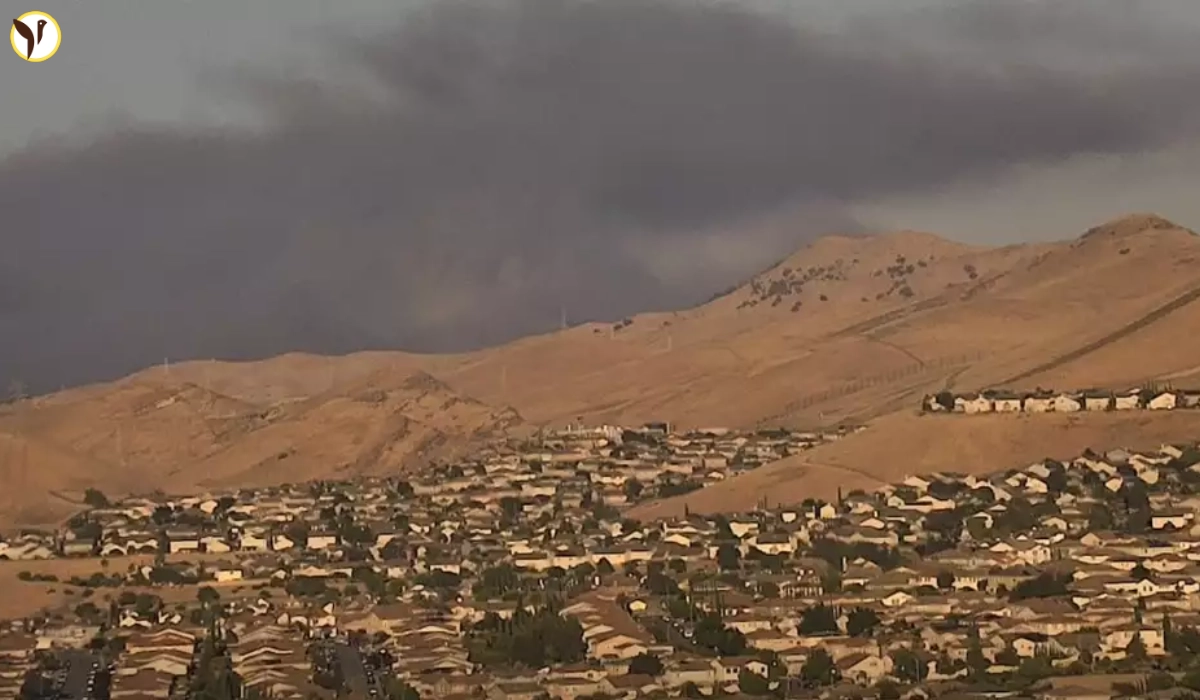A major wildfire broke out on the evening of Wednesday, June 19, in Antioch, California, prompting swift emergency action and evacuation warnings for local residents. The fire began near the intersection of Somersville Road and James Donlon Boulevard, an area located close to the scenic Black Diamond Mines Regional Preserve.
It spread quickly across dry brushland, fueled by warm weather and wind. Within just a couple of hours, the fire had grown to more than 200 acres.
Emergency crews from the Contra Costa County Fire Protection District were joined by CAL FIRE teams as the fire rapidly expanded. Ground firefighters worked alongside air support units that dropped water to slow the spread.
By late evening, officials reported that they had successfully stopped the fire from advancing, although crews continued to manage flare-ups and remaining hot spots throughout the night.
Due to the fire’s close proximity to neighborhoods, local authorities issued evacuation warnings for areas east of the fire zone. These included several streets and residential areas near Cambridge Drive, Markley Creek, and parts of Finch Drive.
Though these were not mandatory orders, residents were urged to prepare to leave if conditions worsened.
In response to the potential danger, the Antioch Police Department opened an evacuation center at Canal Park on Gentrytown Drive. This site provided temporary shelter and assistance to individuals who either chose to evacuate or felt unsafe staying in their homes.
Emergency staff and volunteers were available to help with basic needs and offer information to concerned residents.
Fire officials emphasized that while the immediate threat had been slowed, conditions could change quickly, especially with wind shifts. Residents in affected areas were encouraged to stay alert, keep emergency kits ready, and monitor official updates from local authorities.
The possibility of embers sparking smaller fires in nearby dry areas remained a risk through the evening and into the next day.
Fire investigators are now working to determine the cause of the blaze. No official explanation has been released, but CAL FIRE has launched a formal investigation into how the fire started.
Updates on the investigation are expected once crews have contained the remaining hot spots and it is safe to access the origin point.
This wildfire is part of a growing trend seen across California during the dry summer months. Rising temperatures, low humidity, and dry vegetation have all contributed to an increased risk of wildfires in urban-edge areas like Antioch.
Officials say community awareness and quick emergency response were key in preventing further damage.
As of Thursday morning, fire containment efforts were ongoing, and no damage to homes had been confirmed. One person was injured during the incident and taken to the hospital with non-life-threatening injuries. Authorities are continuing to assess the impact and offer updates as the situation evolves.
literally can’t believe this fire is legit happening so close to my home. i’m glad antioch is getting it under control but man i was not prepared to be inhaling smoke tn… pic.twitter.com/gg37e3b0ie
— d’aujah 🫧 (@daujahmarie) June 19, 2025
Smoke From the Antioch Fire Causes Health Warnings Across the Region
While the wildfire’s flames remained concentrated in Antioch’s hilly outskirts, its effects were felt much farther. As thick smoke moved into eastern Contra Costa County and beyond, local air quality began to decline, prompting public health officials to issue advisories.
The Bay Area Air Quality Management District released an alert warning residents about smoke drifting unpredictably due to changing wind patterns.
Although the fire was contained in a specific area, smoke traveled across several nearby communities, reducing visibility and potentially causing breathing problems. This led to recommendations for people to remain indoors, especially those with pre-existing respiratory or heart conditions.
Health officials urged residents to close windows and doors, use air purifiers if available, and avoid outdoor exercise until the air cleared. Children, the elderly, and individuals with asthma or other chronic illnesses were considered especially vulnerable.
Many schools and care centers took precautions, keeping children indoors during recess or cancelling outdoor activities altogether.
As smoke lingered into Thursday morning, local hospitals and clinics remained alert for a possible rise in patients experiencing symptoms related to smoke exposure. These may include coughing, shortness of breath, irritated eyes, or fatigue.
Though there were no widespread medical emergencies reported, public health authorities stressed that wildfire smoke, even from a distance, can cause serious problems for sensitive groups.
Emergency responders and environmental teams closely monitored smoke levels to determine when the situation might improve. In some neighborhoods, residents reported a heavy smell of smoke and a visible haze even though the fire itself was miles away.
This emphasized how wildfire smoke can travel far and affect areas that are not in the direct line of fire.
Meanwhile, firefighters continued to work on full containment of the Somersville Fire, focusing on putting out remaining flames and preventing flare-ups.
Though the worst of the fire appeared to be under control by Thursday afternoon, fire crews warned that high temperatures and dry conditions could lead to new fires in the region.
CAL FIRE officials repeated that the exact cause of the fire is still under investigation. They encouraged residents to report any suspicious activity or fire hazards they might see, and to always follow local fire safety rules—especially during peak fire season.
This event serves as a reminder of how wildfires can impact both physical safety and public health. Even after flames are contained, the effects of smoke can linger, affecting thousands of residents.
With wildfire season just beginning in California, authorities stressed the importance of staying prepared and informed as conditions continue to change.


/content/stories/thumb/thumb691d5a7995a377.09771198.webp)
/content/stories/thumb/thumb691c6883320f32.63242210.webp)
/content/stories/thumb/thumb691c595f806732.26187823.webp)
/content/stories/thumb/thumb691c49335a4bc3.80041055.webp)
/content/stories/thumb/thumb691c3c61988637.81812691.webp)


